The turquoise waters of the Maldives, the ancient temples of Cambodia, the bustling markets of Marrakech – these are the siren songs of modern travel, beckoning us with promises of adventure and escape. But behind the Instagram-worthy sunsets and exotic experiences, a darker reality simmers. Are we, in our quest to see the world, actually destroying the very places we’re so eager to explore? The concept of sustainable tourism has emerged as a potential answer, promising a way to travel responsibly, minimizing our impact on the environment and supporting local communities. But is it all just a well-marketed fantasy?
The Allure and the Illusion
At its core, sustainable tourism aims to balance three pillars: environmental protection, economic development, and cultural preservation. It’s a noble goal, no doubt. Imagine tourists leaving a destination better than they found it: reducing waste, supporting local businesses, and respecting local traditions. Sounds idyllic, right? The problem is, achieving this delicate balance is incredibly complex. The tourism industry, by its very nature, can be a resource-intensive machine, often demanding substantial energy, water, and land use. For instance, a study from the UN Environment Programme estimated that tourism accounts for about 5% of global greenhouse gas emissions. The United Nations Environment Programme highlights the urgent need for systemic change to combat these impacts.
Furthermore, the economic benefits of tourism don’t always trickle down to the people who need them most. Large-scale resorts and international tour operators can siphon off profits, leaving local communities struggling. Cultural preservation often faces similar challenges. The commodification of local traditions to attract tourists can lead to their dilution or distortion, transforming authentic cultural practices into staged performances.
The Environmental Footprint: More Than Just Sunscreen
It’s easy to overlook the environmental impact of travel when you’re busy snapping photos. Air travel is a major offender, contributing significantly to carbon emissions. Cruise ships, with their massive size and often outdated technologies, can pollute coastal waters. Even seemingly innocuous activities, like using disposable plastic bottles or over-consuming water, can have a cumulative negative effect.
Consider the construction of hotels and resorts. Often, it means clearing land, disrupting ecosystems, and consuming vast amounts of resources. In some popular destinations, the demand for fresh water from hotels and golf courses has put a strain on local supplies, leading to shortages for residents. The disposal of waste, especially in destinations with inadequate infrastructure, poses another significant challenge. Waste management, or a lack thereof, can lead to pollution of land, water, and the atmosphere.
The Economic Tightrope: Whose Paradise Is It Anyway?
Tourism can be a powerful engine for economic development. It creates jobs, generates revenue, and can lift communities out of poverty. However, the economic benefits of tourism are not always evenly distributed. Often, the profits flow to large corporations and international investors, leaving local communities with limited economic gains.
Another significant issue is the exploitation of local labor. Many tourism-related jobs, such as those in hotels and restaurants, offer low wages, long hours, and poor working conditions. Moreover, the influx of tourists can drive up the cost of living, making it difficult for local residents to afford housing, food, and other necessities. This can lead to resentment and social tension, undermining the very foundations of sustainable tourism. Sustainable tourism requires finding a balance between profit and ethics.
Cultural Preservation: Don’t Be *That* Tourist
Cultural tourism, when done responsibly, can provide valuable opportunities to protect cultural heritage. Visiting museums, historical sites, and engaging with local communities can provide crucial funds for the preservation of these places and traditions. However, when tourism commodifies culture, local practices can be altered to cater to the expectations of tourists. Traditions can become performances. Religious sites become photo ops. What was once authentic and meaningful can be reduced to a superficial caricature.
The impact goes beyond the superficial. Overcrowding and inappropriate behavior can damage historical sites and disrupt the daily lives of local communities. Consider the impacts of overtourism on the Great Wall of China or Machu Picchu. Tourists can literally wear down the foundations of cultural treasures, causing damage that will take generations to repair. In many places, locals who have to deal with the constant barrage of tourists can develop feelings of resentment and frustration.
So, What’s a Traveler to Do?
So, is sustainable tourism a total sham? Not necessarily. But it requires a healthy dose of skepticism and a willingness to travel differently. Start by researching your destination and the companies you’re using. Support locally-owned businesses, choose eco-friendly accommodations, and consider the carbon footprint of your travel choices. This can mean opting for public transportation, offsetting your carbon emissions, or simply spending more time in a single location.
Ultimately, sustainable tourism isn’t just about ticking boxes; it’s about cultivating a mindset of respect and responsibility. Educate yourself on the challenges your visit poses. Be mindful of your consumption habits, support ethical businesses, and seek out authentic experiences. Travel is a privilege, and we have a responsibility to protect the places we visit. The World Travel & Tourism Council (WTTC) provides detailed guidelines for sustainable travel and is a helpful resource in planning your next trip. You can find their information here: World Travel & Tourism Council.
It is time for travelers to make smart choices. Travel needs to change, and you can do your part by getting informed. It’s a start.
And hey, if you’re looking for a way to kickstart your responsible travel efforts, I suggest a mug, perhaps one that can spark conversations over a beverage. Speaking of which, have you seen the crypto coffee mug? Might be a conversation starter when you’re back home talking about your eco-adventures.


